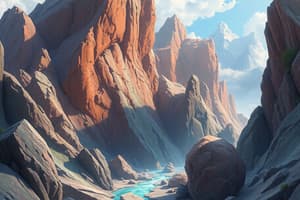Podcast
Questions and Answers
How is the origin of a rock primarily determined?
How is the origin of a rock primarily determined?
- By its location in the earth
- By how brittle it is
- By its color and age
- By examining its texture, composition, and internal structure (correct)
Which type of rock is formed when magma cools and solidifies?
Which type of rock is formed when magma cools and solidifies?
- Metamorphic rock
- Sedimentary rock
- Igneous rock (correct)
- Foliated rock
What process leads to the formation of sedimentary rock?
What process leads to the formation of sedimentary rock?
- Weathering and erosion (correct)
- Metamorphism
- Solidification of magma
- Cooling of molten rock
Which property is typically associated with igneous rocks?
Which property is typically associated with igneous rocks?
What is metamorphism in the rock cycle?
What is metamorphism in the rock cycle?
What color variations can rocks exhibit?
What color variations can rocks exhibit?
Which of the following best describes the process of lithification?
Which of the following best describes the process of lithification?
Which type of rock undergoes the process of metamorphism?
Which type of rock undergoes the process of metamorphism?
What type of mineral's property is usually associated with cleavage?
What type of mineral's property is usually associated with cleavage?
If metamorphic rock is formed from limestone, which type of rock is shale derived from?
If metamorphic rock is formed from limestone, which type of rock is shale derived from?
What does the presence of tiny crystals in igneous rock indicate about its cooling process?
What does the presence of tiny crystals in igneous rock indicate about its cooling process?
What is the primary characteristic of organic sedimentary rocks?
What is the primary characteristic of organic sedimentary rocks?
What effect does water have during hydration in the context of chemical weathering?
What effect does water have during hydration in the context of chemical weathering?
Which physical property is associated with the shininess of minerals like gold and tourmalines?
Which physical property is associated with the shininess of minerals like gold and tourmalines?
Where are the oldest layers of sedimentary rocks typically found within a cliff formation?
Where are the oldest layers of sedimentary rocks typically found within a cliff formation?
Which of the following groups of minerals would most likely exhibit high hardness on Moh's Hardness Scale?
Which of the following groups of minerals would most likely exhibit high hardness on Moh's Hardness Scale?
What is the process called by which loose sediments are transformed into hard sedimentary rocks?
What is the process called by which loose sediments are transformed into hard sedimentary rocks?
Which type of sedimentary rock is primarily formed from the mechanical weathering of other rocks?
Which type of sedimentary rock is primarily formed from the mechanical weathering of other rocks?
What characterizes organic sedimentary rocks?
What characterizes organic sedimentary rocks?
What determines the crystal shape of a mineral?
What determines the crystal shape of a mineral?
Which sedimentary rock is made up of cemented grains of sand or quartz?
Which sedimentary rock is made up of cemented grains of sand or quartz?
What defines minerals generally as opposed to rocks?
What defines minerals generally as opposed to rocks?
Which of the following is a common method for mineral identification?
Which of the following is a common method for mineral identification?
Which of the following statements about chemical sedimentary rocks is true?
Which of the following statements about chemical sedimentary rocks is true?
Flashcards are hidden until you start studying
Study Notes
Sedimentary Rock Formation
- Sedimentary rocks form through lithification, a process that cements soft, unconsolidated sediments into hard rocks.
- Three main types of sedimentary rocks:
- Clastic: Derived from mechanical weathering; consists of smaller rock fragments (clasts) that accumulate and lithify.
- Chemical: Formed when dissolved materials precipitate from liquid, resulting in solid substances.
- Organic: Formed from accumulated organic debris, often containing fossils from plants and animals.
Examples of Sedimentary Rocks
- Conglomerate: Composed of pebbles and gravel cemented together.
- Sandstone: Made of sand or quartz grains, typically colored red, yellow, or brown.
- Coal: A combustible rock mainly made of carbonized plant matter, commonly found in underground deposits.
Mineralogy and Minerals
- Mineralogy is the study of minerals, which are naturally formed, inorganic, crystalline solids with a specific chemical composition and ordered atomic arrangement.
- Minerals of the same kind exhibit identical crystal shapes, a reflection of their atomic structure.
Weathering and Erosion Concepts
- Physical or chemical weathering can break down rocks; examples include freeze-thaw cycles, acid rain, and wind erosion.
- Erosion involves processes like wind blowing sediment away and water breaking down rocks.
The Rock Cycle
- Rocks transform from one type to another through the rock cycle, characterized by:
- Formation of igneous rocks from cooling magma.
- Weathering and erosion to create sediments.
- Compaction and cementation (lithification) forming sedimentary rocks.
- Metamorphism wherein sediments or igneous rocks undergo heat and pressure to form metamorphic rocks.
- Melting of metamorphic rocks to produce magma, restarting the cycle.
Properties of Rocks
- Color can vary significantly (dark, light, reddish, gray, brown, yellow, black).
- Texture differs; may be fine or coarse, glossy or dull.
- Rocks vary in hardness, with some being hard and others brittle.
Additional Characteristics of Minerals
- Cleavage is the tendency to break along planes of weak bonding; related to the structural properties of the minerals.
- Luster indicates the shine or glossiness of minerals, as seen in gold and tourmalines.
Rock Classification
- Rocks are classified according to their formation origins: igneous (from fire), sedimentary (from compressed sediments), and metamorphic (from altered rocks).
- Identification and classification depend on examining texture, composition, and internal structure.
Studying That Suits You
Use AI to generate personalized quizzes and flashcards to suit your learning preferences.





